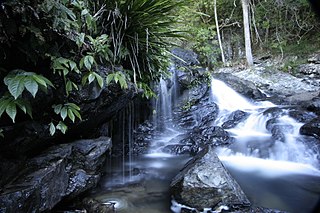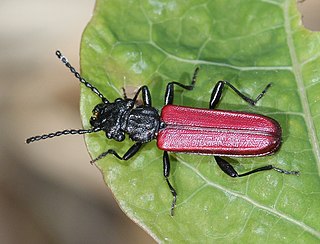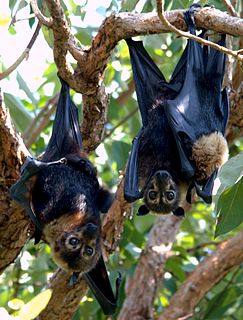
Bindarri National Park is a national park in New South Wales, Australia, 431 km northeast of Sydney.

The Mount Royal National Park is a protected national park located in the Hunter region of New South Wales, Australia. Gazetted in 1997, the 6,920-hectare (17,100-acre) park is situated approximately 187 kilometres (116 mi) north of Sydney.

Bulbophyllum is a genus of mostly epiphytic and lithophytic orchids in the family Orchidaceae. It is the largest genus in the orchid family and one of the largest genera of flowering plants with more than 2,000 species, exceeded in number only by Astragalus. These orchids are found in diverse habitats throughout most of the warmer parts of the world including Africa, southern Asia, Latin America, the West Indies, and various islands in the Indian and Pacific Oceans. Orchids in this genus have thread-like or fibrous roots that creep over the surface of trees or rocks or hang from branches. The stem is divided into a rhizome and a pseudobulb, a feature that distinguished this genus from Dendrobium. There is usually only a single leaf at the top of the pseudobulb and from one to many flowers are arranged along an unbranched flowering stem that arises from the base of the pseudobulb. Several attempts have been made to separate Bulbophyllum into smaller genera, but most have not been accepted by the World Checklist of Selected Plant Families.

Threatened species are any species which are vulnerable to endangerment in the near future. Species that are threatened are sometimes characterised by the population dynamics measure of critical depensation, a mathematical measure of biomass related to population growth rate. This quantitative metric is one method of evaluating the degree of endangerment.

The Cucujidae, "flat bark beetles," are a family of distinctively flat beetles found worldwide under the bark of dead trees. The family has received considerable taxonomic attention in recent years and now consists of 59 species distributed in four genera. It was indicated Cucujus species are scavengers, only feeding on pupae and larvae of other insects and on other subcortical beetles such as their own. Since the Cucujidae prey on larvae of potentially tree damaging beetles that spread fungal diseases, they are considered to be beneficial to the health of living trees.

Quassia amara, also known as amargo, bitter-ash, bitter-wood, or hombre grande is a species in the genus Quassia, with some botanists treating it as the sole species in the genus. The genus was named by Carl Linnaeus who named it after the first botanist to describe it: the Surinamese freedman Graman Quassi. Q. amara is used as insecticide, in traditional medicine and as additive in the food industry.

The spectacled flying fox, also known as the spectacled fruit bat, is a megabat that lives in Australia's north-eastern regions of Queensland. It is also found in New Guinea and on the offshore islands including Woodlark Island, Alcester Island, Kiriwina, and Halmahera.

The black-flanked rock-wallaby, also known as the black-footed rock-wallaby or warru, is a species of wallaby, one of several rock-wallabies in the genus Petrogale. A shy, nocturnal herbivore, its two main subspecies are found in mostly isolated populations across western and southern Western Australia (WA) and parts of South Australia (SA). With some subspecies showing a decline in populations in recent years, the whole species is classed as an endangered species under the Commonwealth EPBC Act.
The narrow sawfish(Anoxypristis cuspidata), also known as the pointed sawfish or knifetooth sawfish, is a species of sawfish in the family Pristidae, part of the Batoidea, a superorder of cartilaginous fish that include the rays and skates. Sawfish display a circumglobal distribution in warm marine and freshwater habitats. Their extant biodiversity is limited to five species belonging to two genera. The sawfishes are characterised by the long, narrow, flattened rostrum or extension on their snout. This is lined with sharp transverse teeth, arranged in a way that resemble the teeth of a saw and are used for killing prey. It is found in the shallow coastal waters and estuaries of the Indo-West Pacific, ranging from the Red Sea and the Persian Gulf to southern Japan, Papua New Guinea and northern Australia. It is the only living member of the genus Anoxypristis, but was previously included in the genus Pristis. Compared to Pristis, Anoxypristis has a narrower rostral saw with numerous teeth on the distal part and no teeth on the basal one-quarter. This endangered species reaches a length of up to 3.5 m (11 ft).
The Carpentarian rock rat is a species of rodent in the family Muridae. It is found only in Australia.
Quassia sanguinea is a species of plant in the Simaroubaceae family. It is found in Cameroon and Nigeria. Its natural habitats are subtropical or tropical moist lowland forests and subtropical or tropical moist montane forests. It is threatened by habitat loss.

Eidothea hardeniana, commonly named nightcap oak, is a species of tree, up to 40 m (130 ft) tall, of the plant family Proteaceae, which botanist Robert Kooyman recognised as a new species only recently in 2002. The species has an official listing as critically endangered on the Australian Commonwealth EPBC Act and as Endangered on the NSW Threatened Species Act. The name hardeniana honours the botanist Gwen Harden. Phylogenetics studies now suggest it represents a basal branch of the Proteoid clade of the Proteaceae.

An endangered species is a species that is very likely to become extinct in the near future, either worldwide or in a particular political jurisdiction. Endangered species may be at risk due to factors such as habitat loss, poaching and invasive species. The International Union for Conservation of Nature (IUCN) Red List lists the global conservation status of many species, and various other agencies assess the status of species within particular areas. Many nations have laws that protect conservation-reliant species which, for example, forbid hunting, restrict land development, or create protected areas. Some endangered species are the target of extensive conservation efforts such as captive breeding and habitat restoration.

Grevillea acropogon is a species of flowering plant in the family Proteaceae and is endemic to a restricted part of southwestern Western Australia. It is a prostrate to erect shrub with pinnatisect leaves with five to seven sharply-pointed lobes, and red flowers.
Adenanthos dobagii, commonly known as Fitzgerald woollybush, is a shrub in the family Proteaceae. It grows to a mere 50 cm high, with crowded small silvery leaves and insignificant pink or cream flowers. It occurs only in southwestern Australia, where it is found in Fitzgerald River National Park on the south coast.
Adenanthos eyrei is a species of shrub in the family Proteaceae. Restricted to a single cliff-top dune system on the remote south coast of Western Australia, it is listed as rare and endangered. It was discovered by E. Charles Nelson in 1973, and formally described and named in 1978.

Quassiasp. 'Moonee Creek', the Moonee quassia, is a shrub found in north eastern New South Wales, Australia. A rare plant, listed as endangered by extinction. However, it has yet to be formally named.

Lambertia orbifolia, commonly known as the roundleaf honeysuckle, is a shrub or small tree that is endemic to the south-west of Western Australia. It has more or less circular leaves and groups of between four and six orange-red flowers.
Hoplocampa testudinea, the apple sawfly or European apple sawfly, is a species of sawfly in the family Tenthredinidae. It is native to Europe but has been accidentally introduced into North America where it became invasive. The larvae feed inside the developing fruits of the apple tree.
Save a Species Walk is an event in New South Wales in Australia focused on preservation of rare and endangered plants.











